Architectural Sustainability and Efficiency of Enhanced Waterproof Coating from Utilization of Waterborne Poly (Siloxane-Imide-Urethane) Copolymers on Roof Surfaces
Abstract
1. Introduction
2. Experiment
2.1. Materials
2.2. Synthesis of Waterborne Poly(Urethane-Siloxane-Imide) (Si-Imide-WPU) Copolymers
2.3. Measurements
2.3.1. Emulsion Particle Size and Stability
2.3.2. Fourier-Transform Infrared Spectroscopy (FTIR)
2.3.3. Weight-Average Molecular Weight
2.3.4. Thermal Properties
2.3.5. Tensile Strength
2.3.6. Environmental Resistance
3. Results and Discussion
3.1. FTIR Spectrum
3.2. Emulsion Particle Size and Weight-Average Molecular Weight
3.3. Thermal Properties
3.3.1. Glass transition Temperature
3.3.2. Thermogravimetric Analysis
3.4. Mechanical Properties
3.5. Environmental Resistance
3.6. Evaluation of Si-Imide-WPU Copolymers on the Benefits of Waterproof Coating
- Thermal properties: heat resistance was greatly improved. The Td5% and Tgh of the Si-imide-WPU copolymers rose respectively from 33.3 to 46.4 °C and from 101.4 to 163.0 °C. The improvement of the Tgh, which was related to the softening temperature, could be significantly helpful for the application of waterproof coatings for roof surfaces exposed to high temperatures.
- Mechanical properties: the breaking strength and elongation at break of the Si-imide-WPU copolymers were slightly higher than that of typical PU, and they complied with the requirements for waterproof coating resins. Moreover, the abrasion resistance of the copolymer also increased approximately from 1.2% to 85.4%, especially for the copolymers with high PDMS content, such as Si-imide-WPU-1.
- Environmental resistance: water and UV resistance are essential for the evaluation of waterproof roof coatings. To the greatest extent, the hydrostatic pressure and moisture permeability of the Si-imide-WPU copolymers increased by 29.6% and 77.9%, respectively, relative to those of typical PU. Furthermore, the UV resistance grew from 77.1% to 96.0%.
4. Conclusions
Author Contributions
Funding
Conflicts of Interest
References
- Hajjar, J.F. Composite steel and concrete structural systems for seismic engineering. J. Constr. Steel Res. 2002, 58, 703–723. [Google Scholar] [CrossRef]
- Huang, P.-J.; Huang, S.-L.; Marcotullio, P.J. Relationships between CO2 emissions and embodied energy in building construction: A historical analysis of Taipei. Build. Environ. 2019, 155, 360–375. [Google Scholar] [CrossRef]
- Real Estate Information Platform of the Ministry of Interior (Taiwan) 2017. Available online: https://pip.moi.gov.tw/ (accessed on 15 October 2019).
- Syu, P.L.; Jhang, S.C. Handbook of Polyurethane Materials, 2nd ed.; Chemical Industry Publisher: Beijing, China, 2011; pp. 660–661. [Google Scholar]
- Motokucho, S.; Nakayama, Y.; Morikawa, H.; Nakatani, H. Environment-friendly chemical recycling of aliphatic polyurethanes by hydrolysis in a CO2-water system. J. Appl. Polym. Sci. 2017, 135, 45897. [Google Scholar] [CrossRef]
- Ferguson, J.; Petrović, Z.S. Thermal stability of segmented polyurethanes. Eur. Polym. J. 1976, 12, 177–181. [Google Scholar] [CrossRef]
- Lin, M.-F.; Shu, Y.-C.; Tsen, W.-C.; Chuang, F.-S. Synthesis of polyurethane-imide (PU-imide) copolymers with different dianhydrides and their properties. Polym. Int. 1999, 48, 433–445. [Google Scholar] [CrossRef]
- Boubakri, A.; Guermazi, N.; Elleuch, K.; Ayedi, H. Study of UV-aging of thermoplastic polyurethane material. Mater. Sci. Eng. A 2010, 527, 1649–1654. [Google Scholar] [CrossRef]
- Karunarathna, M.; Smith, R.C. Valorization of Lignin as a Sustainable Component of Structural Materials and Composites: Advances from 2011 to 2019. Sustainability 2020, 12, 734. [Google Scholar] [CrossRef]
- Briones-Llorente, R.; Carpintero, V.C.; González, S.G.; Montero, E.; Saiz, Á.R. Testing of the Integrated Energy Behavior of Sustainable Improved Mortar Panels with Recycled Additives by Means of Energy Simulation. Sustainability 2019, 11, 3117. [Google Scholar] [CrossRef]
- Li, B.; Zhang, Z.; Wang, X.-G.; Liu, X. Investigation on the Debonding Failure Model of Anchored Polyurea Coating under a High-Velocity Water Flow and Its Application. Sustainability 2019, 11, 1261. [Google Scholar] [CrossRef]
- Lin, M.; Tsen, W.; Shu, Y.; Chuang, F. Effect of silicon and phosphorus on the degradation of polyurethanes. J. Appl. Polym. Sci. 2001, 79, 881–899. [Google Scholar] [CrossRef]
- Mehdipour-Ataei, S.; Mahmoodi, A. New Polyurethane Elastomers with Enhanced Thermal Stability. Polym. Technol. Eng. 2014, 53, 1553–1560. [Google Scholar] [CrossRef]
- Chuang, F.; Tsen, W.; Shu, Y. The effect of different siloxane chain-extenders on the thermal degradation and stability of segmented polyurethanes. Polym. Degrad. Stab. 2004, 84, 69–77. [Google Scholar] [CrossRef]
- Chuang, F.-S.; Tsi, H.-Y.; Chow, J.-D.; Tsen, W.-C.; Shu, Y.-C.; Jang, S.-C. Thermal degradation of poly(siloxane-urethane) copolymers. Polym. Degrad. Stab. 2008, 93, 1753–1761. [Google Scholar] [CrossRef]
- Gaddam, S.K.; Palanisamy, A. Anionic waterborne polyurethane-imide dispersions from cottonseedoil based ionic polyol. Ind. Crop. Prod. 2017, 96, 132–139. [Google Scholar] [CrossRef]
- Gnanarajan, T.P.; Iyer, N.P.; Nasar, A.S.; Radhakrishnan, G. Preparation and properties of poly(urethane-imide)s derived from amine-blocked-polyurethane prepolymer and pyromellitic dianhydride. Eur. Polym. J. 2002, 38, 487–495. [Google Scholar] [CrossRef]
- Bing, H.; Lin, Y. Highly heat-resistant silicon-containing polyurethane-imidecopolymers: Synthesis and thermal mechanical stability. Eur. Polym. J. 2017, 91, 337–353. [Google Scholar]
- Pooladian, B.; Nikje, M.M.A. Synthesis and characterization of novel water-based poly(urethane-imide) nanodispersions. J. Coatings Technol. Res. 2018, 15, 643–647. [Google Scholar] [CrossRef]
- Iuliana, S.; Elena, G.H.; Daniel, T.; Virgil, B.; Dan, S.V. Establishing proper scanning conditions in atomic force microscopy on polyimide and polyurethane samples and their effect on 3D surface texture parameters. Scanning 2015, 37, 335–349. [Google Scholar]
- Sang, X.M.; Wang, R.Z.; Chen, X.G.; Zhang, L.; An, M.; Shen, Y. A Review on Synthesis and Property of Polyurethane-Imide. Adv. Mater. Res. 2011, 284, 1746–1749. [Google Scholar] [CrossRef]
- Ni, H.; Aaserud, D.; Soucek, W.S., Jr.; Soucek, M.D. Preparation and characterization of alkoxysilane functionalized isocyanurates. Polymer 2000, 41, 57–71. [Google Scholar] [CrossRef]
- Mitsui Nisso Corp. Japan Kokai, Tokkyo, Koho. Jpn. Patent 58, 217, 515, 17 December 1983. [Google Scholar]
- Benrashid, R.; Nelson, G.L. Synthesis of new siloxane urethane block copolymers and their properties. J. Polym. Sci. Part A Polym. Chem. 1994, 32, 1847–1865. [Google Scholar] [CrossRef]
- Benrashid, R.; Nelson, G.L.; Linn, J.H.; Hanley, K.H.; Wade, W.R. Surface characterization of segmented siloxane–urethane block copolymers. J. Appl. Polym. Sci. 1993, 49, 523–537. [Google Scholar] [CrossRef]
- Shu, Y.-C.; Lin, M.-F.; Tsen, W.-C.; Chuang, F.-S. Differential scanning calorimetry analysis of silicon-containing and phosphorus-containing segmented polyurethane. I-thermal behaviors and morphology. J. Appl. Polym. Sci. 2001, 81, 3502–3513. [Google Scholar] [CrossRef]
- Deligöz, H.; Yalçınyuva, T.; Özgümüş, S. A novel type of Si-containing poly(urethane-imide)s: Synthesis, characterization and electrical properties. Eur. Polym. J. 2005, 41, 771–781. [Google Scholar] [CrossRef]
- Xiao, X.H.; Yun, W. Preparation and Properties of Silane-Terminated Poly(urethane-Imide). Adv. Mater. Res. 2013, 690–693, 1577–1580. [Google Scholar]
- Zhang, F.-A.; Yu, C.-L. Application of a silicone-modified acrylic emulsion in two-component waterborne polyurethane coatings. J. Coat. Technol. Res. 2007, 4, 289–294. [Google Scholar] [CrossRef]
- Xiong, G.; Kang, P.; Zhang, J.; Li, B.; Yang, J.; Chen, G.; Zhou, Z.; Li, Q. Improved adhesion, heat resistance, anticorrosion properties of epoxy resins/POSS/methyl phenyl silicone coatings. Prog. Org. Coat. 2019, 135, 454–464. [Google Scholar] [CrossRef]
- Liao, S.; Jang, S.C.; Lin, M. Phase Behaviour and Thermal Stability of Imide-Containing Siloxane-Urethane Copolymers. Polym. Polym. Compos. 2008, 16, 153–164. [Google Scholar] [CrossRef]
- Zuo, M.; Takeichi, T. Preparation and characterization of poly(urethane–imide) films prepared from reactive polyimide and polyurethane prepolymer. Polymer 1999, 40, 5153–5160. [Google Scholar] [CrossRef]
- Efimenko, K.; Wallace, W.E.; Genzer, J. Surface modification of Sylgard-184 poly(dimethyl siloxane) networks by ultraviolet and ultraviolet/ozone treatment. J. Colloid Interface Sci. 2002, 254, 306–315. [Google Scholar] [CrossRef]
- Tsen, W.C.; Chuang, F.S. Phase transition and domain morphology of siloxane-containing hard-segmented polyurethane copolymers. J. Appl. Polym. Sci. 2006, 101, 4242–4252. [Google Scholar] [CrossRef]
- Chuang, F. Analysis of thermal degradation of diacetylene-containing polyurethane copolymers. Polym. Degrad. Stab. 2007, 92, 1393–1407. [Google Scholar] [CrossRef]

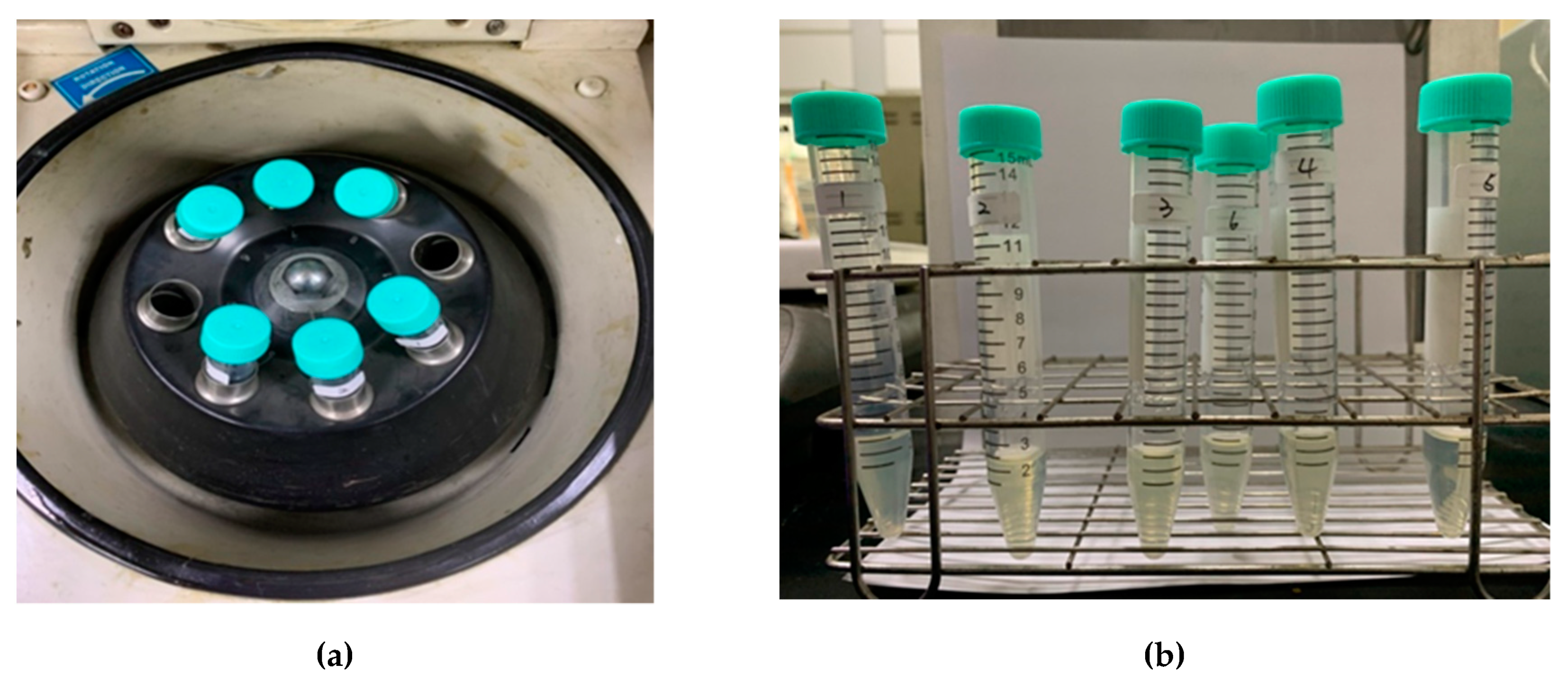
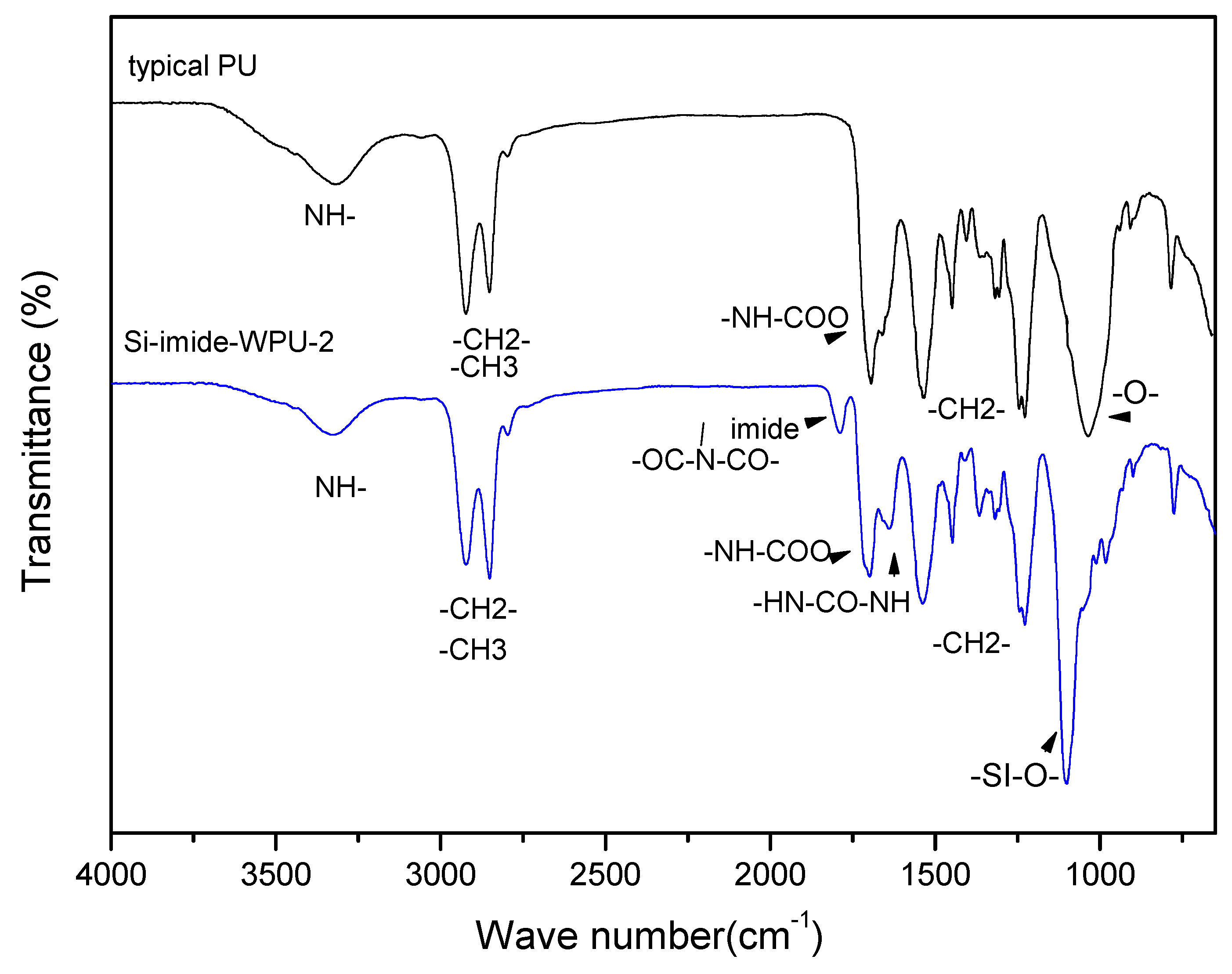

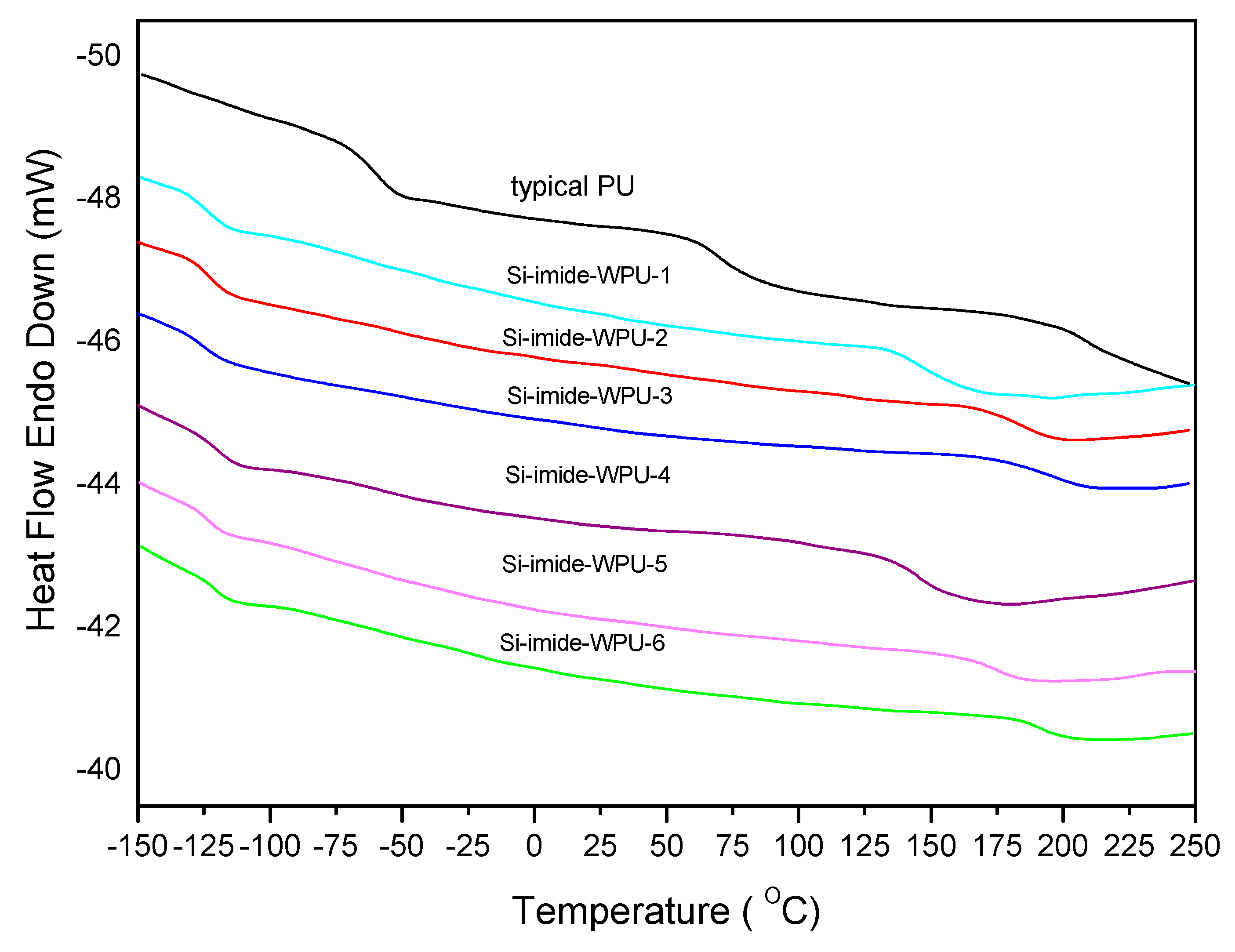
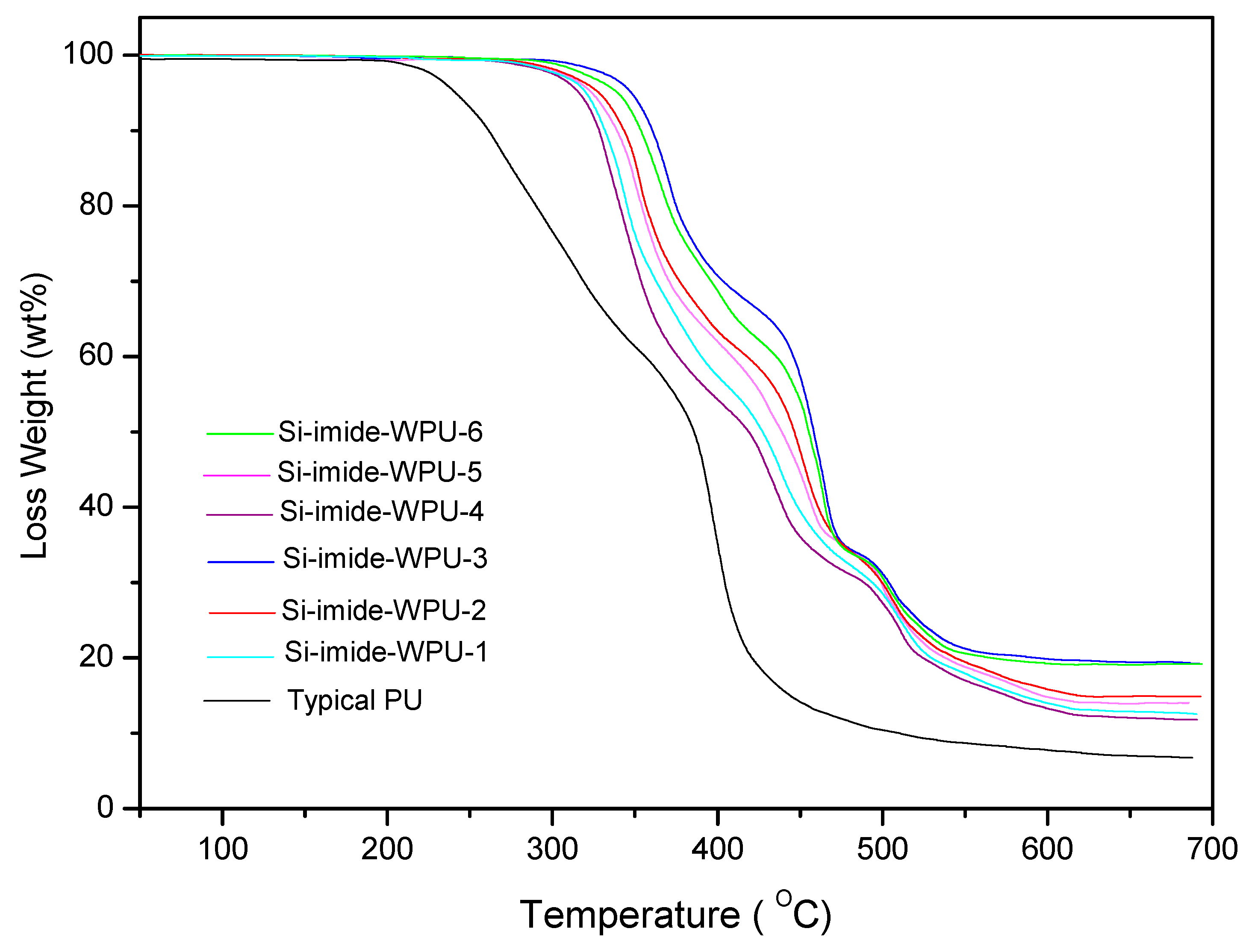
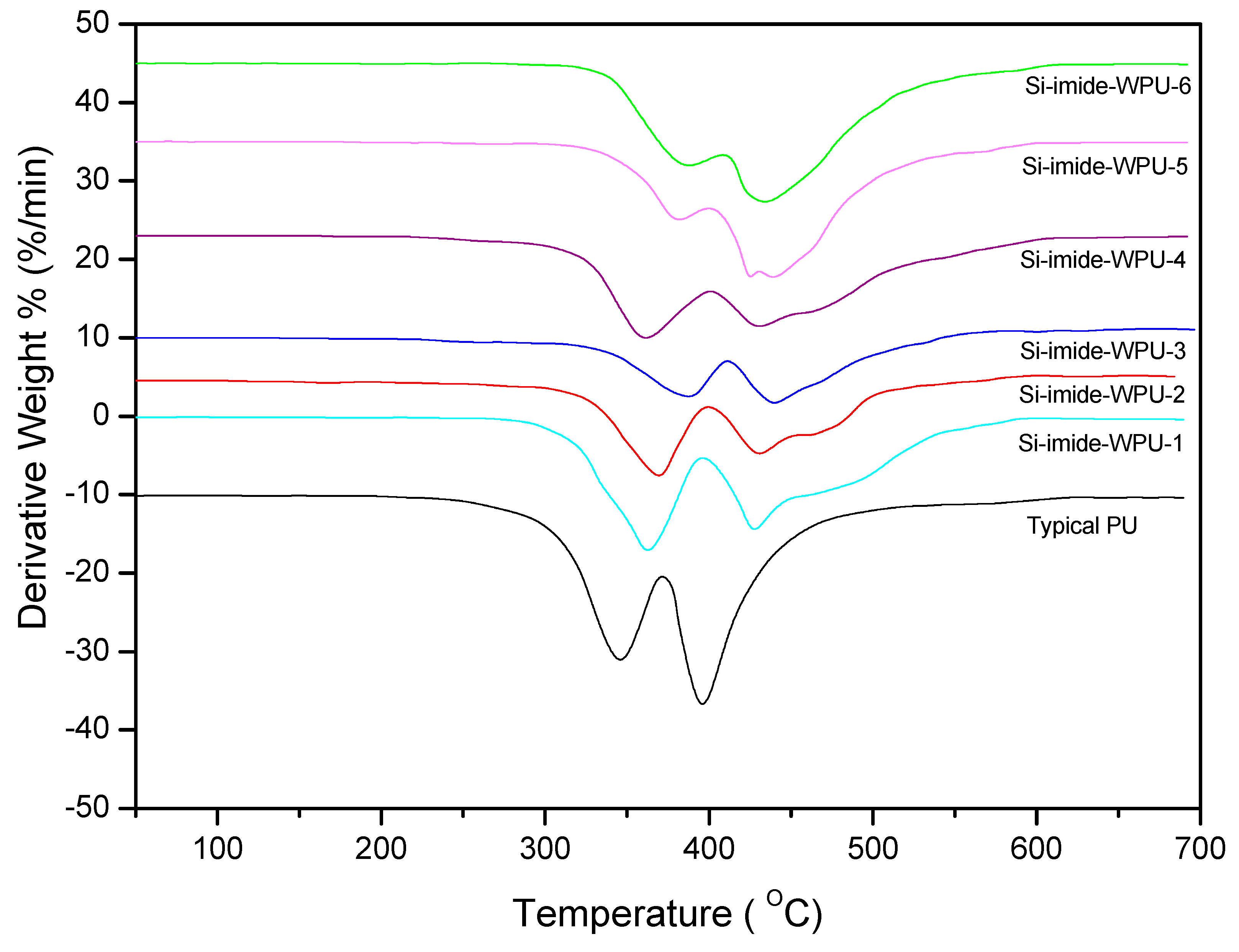
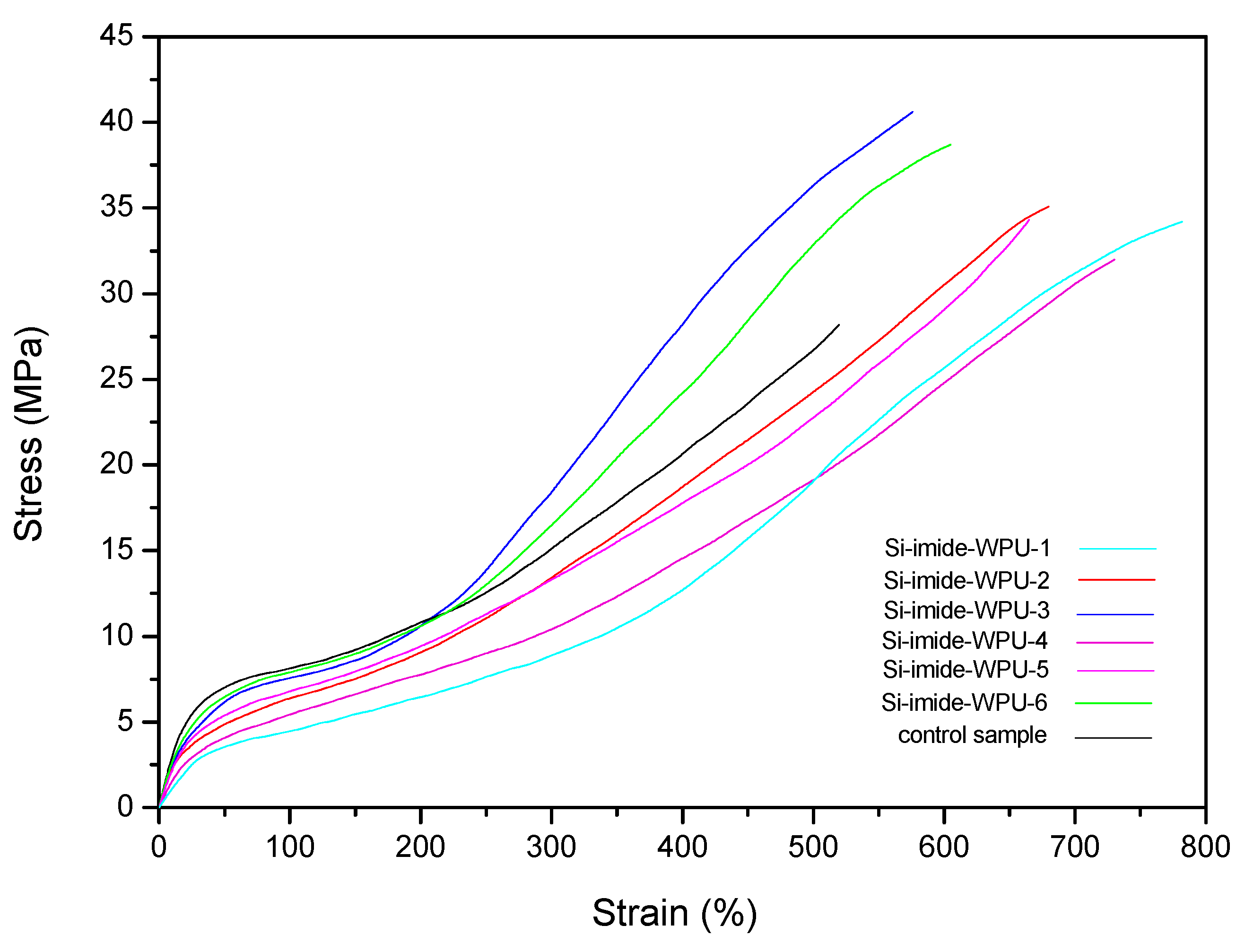
| Code | Monomer Composition | Equivalent Ratio 1 | PDMS (wt%) | PMDA (wt%) | DMPA (wt%) | Hsc 2 (wt%) |
|---|---|---|---|---|---|---|
| Si-imide-WPU-1 | H12MDI/PDMS-PMDA/DMPA/EA | 3/1.5–0.5/0.5/0.5 | 73.3 | 2.9 | 1.8 | 26.70 |
| Si-imide-WPU-2 | H12MDI/PDMS-PMDA/DMPA/EA | 3/1.0–1.0/0.5/0.5 | 62.3 | 7.5 | 2.3 | 37.70 |
| Si-imide-WPU-3 | H12MDI/PDMS-PMDA/DMPA/EA | 3/0.5–1.5/0.5/0.5 | 42.9 | 15.4 | 3.2 | 57.10 |
| Si-imide-WPU-4 | H12MDI/PDMS-PMDA/DMPA/EA | 2/0.75–0.25/0.5/0.5 | 66.8 | 2.7 | 2.1 | 33.20 |
| Si-imide-WPU-5 | H12MDI/PDMS-PMDA/DMPA/EA | 2/0.5–0.5-1/0.25/0.5 | 55.4 | 6.7 | 4.1 | 44.60 |
| Si-imide-WPU-6 | H12MDI/PDMS-PMDA/DMPA/EA | 2/0.25–0.75/0.25/0.5 | 36.7 | 13.2 | 5.4 | 63.30 |
| Code | Average Size (nm) | Mw × 103 (g/mol) |
|---|---|---|
| Si-imide-WPU-1 | 102.5 | 77.7 |
| Si-imide-WPU-2 | 127.6 | 82.7 |
| Si-imide-WPU-3 | 132.2 | 86.0 |
| Si-imide-WPU-4 | 103.7 | 74.6 |
| Si-imide-WPU-5 | 109.1 | 77.0 |
| Si-imide-WPU-6 | 120.3 | 84.4 |
| Typical PU 1 | 119.5 | 72.1 |
| Code | Tgs 2 | Tgh 3 |
|---|---|---|
| Si-imide-WPU-1 | −125 | 151 |
| Si-imide-WPU-2 | −122 | 179 |
| Si-imide-WPU-3 | −123 | 192 |
| Si-imide-WPU-4 | −124 | 147 |
| Si-imide-WPU-5 | −123 | 168 |
| Si-imide-WPU-6 | −121 | 183 |
| Typical PU 1 | −64 | 73 |
| Code | Td5% 2 | Td1max 3 | Td2i 4 | Td2 max 3 | Td3i 4 |
|---|---|---|---|---|---|
| Si-imide-WPU-1 | 320 | 364 | 393 | 426 | 460 |
| Si-imide-WPU-2 | 326 | 371 | 415 | 431 | 463 |
| Si-imide-WPU-3 | 347 | 383 | 417 | 442 | 465 |
| Si-imide-WPU-4 | 316 | 359 | 405 | 430 | 463 |
| Si-imide-WPU-5 | 323 | 378 | 418 | 424/439 5 | - |
| Si-imide-WPU-6 | 346 | 389 | 420 | 435 | - |
| Typical PU 1 | 237 | 345 | 355 | 390 | - |
| Code | Breaking Strength (MPa) | Elongation at Break (%) | Weight Loss of Friction (g) |
|---|---|---|---|
| Si-imide-WPU-1 | 34.3 | 782 | 0.12 |
| Si-imide-WPU-2 | 35.1 | 680 | 0.32 |
| Si-imide-WPU-3 | 40.6 | 576 | 0.58 |
| Si-imide-WPU-4 | 32.1 | 730 | 0.24 |
| Si-imide-WPU-5 | 34.3 | 665 | 0.46 |
| Si-imide-WPU-6 | 38.7 | 605 | 0.71 |
| Typical PU 1 | 28.2 | 520 | 0.82 |
| Code | Breaking Strength after UV Irradiation (MPa) | Elongation at Break after UV Irradiation (%) | Percentage of Decay in Strength after UV Irradiation (%) | Hydrostatic Pressure (cmH2O) | Moisture Permeability (g/m2 × 24 h) |
|---|---|---|---|---|---|
| Si-imide-WPU-1 | 33.7 | 767 | 1.8 | 151 | 2.1 |
| Si-imide-WPU-2 | 33.8. | 636 | 3.7 | 164 | 1.9 |
| Si-imide-WPU-3 | 36.7 | 520 | 9.6 | 175 | 2.0 |
| Si-imide-WPU-4 | 31.2 | 705 | 2.8 | 145 | 2.3 |
| Si-imide-WPU-5 | 32.9 | 618 | 4.1 | 153 | 2.1 |
| Si-imide-WPU-6 | 34.6 | 590 | 10.6 | 166 | 2.5 |
| Typical PU 1 | 15.1 | 290 | 46.4% | 135 | 9.5 |
| Properties | Si-imide-WPU Copolymers | Typical PU | Percentage of Property Increase (%) |
|---|---|---|---|
| Temperatures of thermal degradation (Td5%) (°C) | 316–347 | 237 | 33.3–46.4 |
| Glass transition temperature of hard segment (Tgh)(°C) | 147–192 | 73 | 101.4–163.0 |
| Breaking strength (MPa) | 32.1–40.6 | 28.2 | 13.8–44 |
| Elongation at break (%) | 576–782 | 520 | 10.7–50.4 |
| Abrasion resistance (Weight loss) (g) | 0.12–0.71 | 0.82 | 85.4–1.2 |
| Percentage decrease in intensity (%) after UV irradiation | 1.8–10.6% | 46.4% | 96.0–77.1 |
| Water pressure resistance (cmH2O) | 145–175 | 135 | 7.4–29.6 |
| Moisture permeability (g/m2 × 24 h) | 1.9–2.5 | 9.5 | 80.0–73.7 |
| Properties | Growth Percentage (%) | Average Percentage (%) of Growth | |||||
|---|---|---|---|---|---|---|---|
| Si-Imide-WPU-1 | Si-Imide-WPU-2 | Si-Imide-WPU-3 | Si-Imide-WPU-4 | Si-Imide-WPU-5 | Si-Imide-WPU-6 | ||
| Temperatures of thermal degradation (Td5%) | 35.0 | 37.6 | 46.4 | 33.3 | 36.3 | 46.0 | 39.1 |
| Glass transition temperature of hard segment (Tgh) | 106.8 | 145.2 | 163.0 | 101.4 | 130.1 | 150.7 | 132.9 |
| Breaking strength | 21.6 | 24.5 | 44.0 | 13.8 | 21.6 | 37.2 | 27.1 |
| Elongation at break | 50.4 | 30.8 | 10.8 | 40.4 | 27.9 | 16.3 | 29.4 |
| Abrasion resistance | 85.4 | 61.0 | 29.3 | 70.7 | 43.9 | 13.4 | 50.6 |
| Percentage decrease in intensity after UV irradiation | 96.1 | 92.0 | 79.3 | 94.0 | 91.2 | 77.2 | 88.3 |
| hydrolysis-resistance | 11.9 | 21.5 | 29.6 | 7.4 | 13.3 | 23.0 | 17.7 |
| Moisture permeability | −77.9 | −80.0 | −78.9 | −75.8 | −77.9 | −73.7 | −77.4 |
© 2020 by the authors. Licensee MDPI, Basel, Switzerland. This article is an open access article distributed under the terms and conditions of the Creative Commons Attribution (CC BY) license (http://creativecommons.org/licenses/by/4.0/).
Share and Cite
Hsu, Y.-T.; Wang, W.-H.; Hung, W.-H. Architectural Sustainability and Efficiency of Enhanced Waterproof Coating from Utilization of Waterborne Poly (Siloxane-Imide-Urethane) Copolymers on Roof Surfaces. Sustainability 2020, 12, 4411. https://doi.org/10.3390/su12114411
Hsu Y-T, Wang W-H, Hung W-H. Architectural Sustainability and Efficiency of Enhanced Waterproof Coating from Utilization of Waterborne Poly (Siloxane-Imide-Urethane) Copolymers on Roof Surfaces. Sustainability. 2020; 12(11):4411. https://doi.org/10.3390/su12114411
Chicago/Turabian StyleHsu, Yao-Tang, Wen-Hsin Wang, and Wei-Hsi Hung. 2020. "Architectural Sustainability and Efficiency of Enhanced Waterproof Coating from Utilization of Waterborne Poly (Siloxane-Imide-Urethane) Copolymers on Roof Surfaces" Sustainability 12, no. 11: 4411. https://doi.org/10.3390/su12114411
APA StyleHsu, Y.-T., Wang, W.-H., & Hung, W.-H. (2020). Architectural Sustainability and Efficiency of Enhanced Waterproof Coating from Utilization of Waterborne Poly (Siloxane-Imide-Urethane) Copolymers on Roof Surfaces. Sustainability, 12(11), 4411. https://doi.org/10.3390/su12114411




